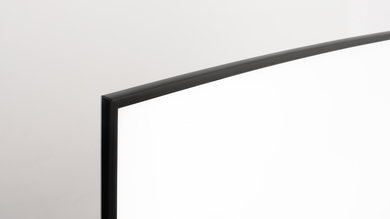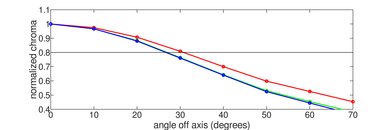The Samsung RU7300 is an okay 4k TV that delivers decent picture quality on a curved screen. Its VA panel can produce deep blacks, which is great for dark room viewing, and its outstanding low input lag provides a responsive gaming experience. However, it lacks advanced gaming features like FreeSync, and its refresh rate is limited to 60Hz. Furthermore, its response time is poor, which results in a bit more motion blur during fast-moving scenes. Its HDR performance is quite limited, as it can't display a wide color gamut and doesn't get very bright. It has good color accuracy, though, and Samsung's Tizen OS is a good, user-friendly platform that has tons of apps available.
Our Verdict
The Samsung RU7300 is an okay TV for most uses. Its VA panel can produce deep and uniform blacks, making it a good choice for dark room viewing. It has decent reflection handling and can get bright enough for a moderately-lit room. It has excellent low input lag for gaming, but it doesn't support any variable refresh rate technologies to reduce screen tearing. Unfortunately, it can only provide an okay HDR experience, as it can't display a wide color gamut and can't get bright enough to make highlights pop.
- Produces deep, uniform blacks.
- Excellent low input lag.
- Disappointing viewing angles.
- Limited HDR performance.
The Samsung RU7300 is an okay TV for watching movies. It produces deep blacks but lacks a local dimming feature to improve dark room performance. Although its poor response time results in more motion blur, it also causes less stutter in 24p movies. Unfortunately, it can't remove judder from any source but can interpolate movies up to 60Hz, if you enjoy the soap opera effect.
The Samsung RU7300 is a decent TV for watching TV shows. Its VA panel has poor viewing angles, so it's not the best choice if you like to walk around while watching. It has decent SDR peak brightness and reflection handling, so you shouldn't have any issues in a moderately-lit room, but the curved screen causes some reflections to smear across the screen, which may be distracting in some cases. It can upscale lower-resolution content well, and you can safely leave the news running all day long with no risks of permanent burn-in.
The Samsung RU7300 is an okay TV for watching sports. Its response time is a bit slow and there's some dirty screen effect in the middle of the screen, which can be distracting. Unfortunately, it isn't bright enough to overcome glare in a bright room, and its poor viewing angles aren't well-suited for watching the big game with a large group of friends. On the upside, it can upscale lower-resolution content like cable sports well, and it has an optional black frame insertion feature that can help reduce motion blur.
The Samsung RU7300 is a decent TV for playing video games. It has outstanding low input lag, but its response time is poor, so fast-moving objects have a bit of blur behind them. The backlight's flicker frequency also causes some duplication of the image, which can be rather distracting. There's no FreeSync support, but it does support most common resolutions, including 1440p, which is great.
The Samsung RU7300 is a mediocre TV for watching HDR movies. It can produce deep and uniform blacks thanks to the VA panel's high contrast ratio, however, it lacks a local dimming feature. Unfortunately, it can't get very bright in HDR, and can't display a wide color gamut, so HDR content won't look significantly different from SDR content. Additionally, it can't remove judder from any source.
The Samsung RU7300 is an okay TV for HDR gaming. It has outstanding low input lag and supports most common resolutions, however, it has a poor response time and there are noticeable duplications in some motion due to the PWM flicker of the backlight. Its HDR performance is severely limited by the lack of a wide color gamut and it can't get bright enough to make a dramatic difference from SDR.
The Samsung RU7300 is a decent TV for use as a PC monitor. It can display full 4:4:4 chroma with no issues and it supports most common resolutions. Input lag is low, but its slow response time means there's more noticeable blur trail behind fast-moving objects. Its VA panel has poor viewing angles, so the images look washed out at the sides if you sit too close. Thankfully, you won't have to worry about permanent burn-in, as most VA panels are immune.
Changelog
- Updated May 21, 2020: Converted to Test Bench 1.5.
- Updated Feb 21, 2020: Converted to Test Bench 1.4.
- Updated May 10, 2019: Review published.
- Updated May 08, 2019: Early access published.
Check Price
Differences Between Sizes And Variants
We tested the 55" (UN55RU7300) version FA01. For the most part, we expect our review to be valid for the 49" model (which is only available in the UK) and the 65" model.
If someone comes across a different type of panel or if their Samsung RU7300 doesn't correspond to our review, let us know and we will update the review.
| Size | Model Short | US | UK |
| 49" | UE49RU7300 | - | UE49RU7300KXXU |
| 55" | UN55RU7300 | UN55RU7300FXZA | UE55RU7300KXXU |
| 65" | UN65RU7300 | UN65RU7300FXZA | UE65RU7300KXXU |
The UN55RU7300 we reviewed was manufactured in February 2019.
Compared To Other TVs

The Samsung RU7300 is a good entry-level curved UHD TV, but there are better TVs for less. It's succeeded by the 2020 Samsung TU8300. See our recommendations for the best TVs, the best HDR gaming TVs, and the best smart TVs.
The Samsung RU8000 is a better TV than the Samsung RU7300. The RU8000 can get quite a bit brighter, especially for HDR content, and has better gray uniformity, better reflection handling, and a much wider color gamut.
The Samsung RU7300 and the Samsung TU8000 are very similar TVs in terms of performance. The TU8000 has much better black uniformity, response time, and a bit better reflection handling, while the RU7300 has a somewhat better input lag, peak brightness, and better gray uniformity. The real differences are in their design as the RU7300 is a curved screen TV, while the TU8000 is flat.
The Samsung NU8000 is much better than the Samsung RU7300. The NU8000 can get brighter and can handle bright room reflections better. The NU8000 also delivers a better dark room performance thanks to its local dimming feature, and motion looks crisper on the NU8000 due to the faster response time. The Samsung RU7300 is a curved TV that delivers a little lower input lag, which matters for video games.
The Samsung RU7300 and Samsung RU7100 are extremely similar, but the RU7300 has a curved screen. Other than that, they're essentially the same TV.
Test Results

The Samsung RU7300 is a budget 4k TV and is the only curved TV that has been announced for Samsung's 2019 lineup so far. It's very similar to the Samsung RU7100 and replaces 2018's Samsung NU7300. Except for the curved screen, it's mainly comparable to other budget TVs, like the LG UM7300 and the Sony X800G.
The Samsung RU7300 has an excellent design, nearly identical to the NU7300, but with a curved screen. The bezels are thin on all sides and the wide-set stand supports the TV well. Due to the curvature of the screen, the TV is quite a bit thicker than non-curved models, so it sticks out a bit more when wall-mounted.
The back is plain and it has a horizontal texture etched into it. There are grooves to guide the cables towards the feet and you can attach them using the provided clips, serving as basic cable management.
The TV can also be VESA mounted, but requires special spacers (included in the box) due to the curvature of the back.
Decent overall build quality. Although it isn't made from premium materials, there aren't any obvious issues with the construction.
There's a stuck pixel in the bottom left side of the screen; it can be seen in our Black Uniformity image. This can occur with any TV and isn't necessarily indicative of any quality control issues with the Samsung RU7300.
The Samsung RU7300 has an excellent native contrast ratio, great for watching movies in a completely dark room. Unfortunately, there's no local dimming feature to improve the contrast.
This TV doesn't have a local dimming feature. The above video is provided for reference only.
This TV has a mediocre peak brightness. The brightness is fairly consistent when displaying different content, with only the 2% window being noticeably dimmer due to the TV's CE dimming (frame dimming). It's bright enough for use in dark to moderately-lit rooms, but it won't be able to overcome glare in very bright rooms.
SDR Peak Brightness was measured after calibration, using the 'Movie' Picture Mode, with the Color Tone set to 'Warm 2,' and Gamma set to '2.2.' Different settings may be brighter.
This TV has a disappointing HDR peak brightness. Small highlights in dark scenes are dimmed by the TV's frame dimming (CE dimming) feature, which unfortunately can't be disabled.
We measured HDR Peak Brightness in the 'Movie' Picture Mode, with our pre-calibration settings.
The Samsung RU7300 has a decent gray uniformity, very similar to the RU7100. The edges of the screen are a bit darker than the center, and there's some noticeable dirty screen effect (DSE) around the center, which may disappoint some sports fans. The uniformity is much better in very dark scenes.
The TV has disappointing viewing angles, like the majority of VA TVs. The image becomes washed out even slightly off-angle, and the image gets gradually darker the further away you are from the center. Colors remain accurate to a wider angle but gradually lose accuracy.
The TV has outstanding black uniformity, despite the lack of a local dimming feature. Some clouding is noticeable, especially in the top right corner of our unit, but this may vary between individual units.
There's a stuck pixel noticeable in the black uniformity image. This wasn't very noticeable in normal content, and we don't expect it to have any impact on our test results.
Before calibration, the color accuracy is good. There are inaccuracies with several colors and the color temperature is much warmer than our 6500K target, resulting in a slight reddish tint. White balance is off as well, and gamma doesn't follow the target at all, with most scenes looking brighter than they should.
After calibration, the color accuracy is outstanding. White balance and gamma are nearly perfect, and the color temperature is much closer to our 6500K target. However, there are still some noticeable inaccuracies with reds and blues.
Changing the Color Space Settings from 'Auto' to 'Custom' caused a noticeable reduction in the color gamut, same as the RU7100. We recommend leaving this set to 'Auto.'
See our recommended settings here.
The TV has a decent color gamut but falls short of being able to display a wide color gamut. It can't display the wide range of greens and reds needed for HDR content to really stand out. Unfortunately, in both 'Movie' and 'Game' mode, the RU7300 does not follow the PQ curve very well, and most scenes appear dimmer than the content creator intended.
If you find HDR too dim, see our recommended settings here. With these settings, the RU7300 is noticeably brighter in HDR, as shown in this EOTF.
The TV has a disappointing color volume; limited by the lack of a wide color gamut. Like many TVs, it can't produce very bright blues, and it can't produce dark, saturated colors well despite the excellent contrast ratio.
The Samsung RU7300 has a good gradient handling. There's some banding in all dark shades, which may be distracting in dark scenes, but otherwise shouldn't be very noticeable. The Digital Clean View setting, which is effective at removing banding on some other Samsung TVs, is not able to remove banding on the RU7300.
We don't expect VA panels to experience permanent image retention, as the VA panel in our long-term test appears immune.
The Samsung RU7300 has a poor response time. Transitions in dark scenes are noticeably slower, resulting in a bit more motion blur. There are noticeable duplications in the above motion photo due to the TV's backlight flicker.
This TV uses PWM (Pulse-Width Modulation) to dim the backlight, except when at 100%. The backlight flickers at 240Hz in 'Movie' mode, which causes some duplications in motion, as seen in the response time motion photo.
Like many other Samsung TVs we've tested, the flicker frequency decreases to 120Hz in other modes, including if Auto Motion Plus is set to 'Custom,' and in 'PC' mode. This fairly low flicker frequency may bother some people.
This TV has an optional Black Frame Insertion (BFI) feature. When enabled, the backlight always flickers at 60Hz, but like the RU7100, the pulse timing isn't very good, causing some double images like the photo above.
In 'Game' mode, BFI isn't available, and the backlight always flickers at 120Hz.
See here to learn how to enable Black Frame Insertion on the RU7300.
The TV has an optional motion interpolation that can only interpolate lower frame rate content up to 60Hz. The TV does a good job overall and there are very few artifacts. Like most TVs, when it can't keep up with demanding scenes, it will stop interpolating, which can cause a sudden change in frame rate, which may be noticeable. Unlike the higher-end Samsung TVs, the Samsung RU7300 doesn't support low latency motion interpolation in 'Game' mode.
Like other Samsung TVs we've tested, the flicker frequency on the Samsung RU7300 decreases to 120Hz when Auto Motion Plus is enabled. This fairly low flicker frequency may bother some people.
See here to learn how to enable motion interpolation on the Samsung RU7300.
The TV's slower response time results in less stutter, which is great for watching movies.
The Samsung RU7300 can't remove judder from any source, even with Auto Motion Plus enabled. This is somewhat expected, as budget Samsung TVs like the RU7100 and NU7300 usually can't remove judder.
The Samsung RU7300 has a basic 60Hz refresh rate and doesn't support any variable refresh rate technologies.
The Samsung RU7300 has outstanding low input lag in most modes, as long as either 'Game' or 'PC' mode is used. It also supports Auto Low Latency mode when connected to a supported console, but CEC has to be enabled (Anynet+).
Most common resolutions are supported at 60Hz, and all modes can display proper 4:4:4 chroma, as long as the input label is set to 'PC.' In 'PC' mode, only the 'Standard' and 'Dynamic' picture modes are available.
The Samsung RU7300 has a dedicated component input on the back, unlike the NU7300, which requires an adapter.
Unlike the NU7300, the Samsung RU7300 supports 5GHz Wi-Fi.
The Samsung RU7300 can pass Dolby Digital through ARC and optical, but not DTS, like the 2018 models. It also supports lossy Dolby Atmos when played from Dolby Digital Plus sources, like Netflix.
The frequency response is mediocre. The low-frequency extension (LFE) is at 80Hz, which is decent. This results in a bass that has a good punch but lacks any thump or rumble. Above the LFE, the response is relatively flat, which results in clear and intelligible dialog. It can get passably loud, but not loud enough for large or noisy environments. Unlike the Samsung QLEDs, like the Q60R and Q900R, there's no room correction feature.
The distortion performance is decent. The total amount of distortion under normal loads is passable and only increases a bit under max loads.
The Samsung RU7300 runs on Tizen OS, but it's a slightly cut down version compared to other higher-end Samsung TVs, as there's less animation. It's easy to use and runs smoothly for the most part, although it did crash once. There's an overscan bug when switching out of 'PC' mode that causes parts of the screen to be cut off. To resolve this issue, simply go to the 'Picture Size' menu without changing anything.
Samsung's app store has a large selection of apps. Most of them run fairly smoothly, with only a few hiccups here and there. The built-in media app can play most common files from an external storage device.
The remote control is the same basic remote that comes with the RU7100. It's an IR remote, so line of sight is required to use it, and it doesn't have a built-in microphone for voice control.
- Quick Setup Guide
- Batteries
- VESA spacers
- Remote
- User manual
Not shown:
- Power cable
- Cable management clips for the legs, shown here



























































































